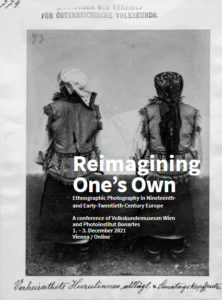
© Volkskundemuseum Wien
Inv.-Nr. pos/774 in der Fotosammlung
des Volkskundemuseum Wien ©
The photo collection of the Volkskundemuseum Wien was established along the lines of a “comparative ethnology of Europe” in the late nineteenth century, focusing on the territories of the Habsburg Monarchy. Today, the assembled materials raise manifold questions about their origins and, as a consequence, about the visual ethnography of “one’s own”.
Just as colonial ethnography created an image of the “others,” ethnographers and folklorists in Europe approached their “own” populations within the continent. The work here is always asymmetrical; it was the ethnographers and photographers who determined what the image of those studied by them looked like. Ethnography at the time conceived “people” with a respective essence in mind. It designed primitivizing and exoticizing typologies, such as in the form of so-called type photography—a genre of images that circulated far beyond the narrow scientific context and could serve the most diverse purposes.
In these photographs, scientific, political, and commercial interests interwove to form imaginary spaces that unfolded their effect in nationalist, imperial, but also tourist discourses. They were used to “preserve” what was about to disappear and to support a wide variety of arguments. They predetermined who was to be seen in which role and who remained invisible, and distinguished between “one’s own” and the “other”. Ethnographic photography depicted its object but also constructed it in doing so. It contributed to the constitution of the scientific subject of “one’s own people”.
The conference is less concerned with motifs than with the genesis and the use of these photographs. How did the construction, production, and commercialization as well as multifariously intersecting interests entwine? How did these images contribute to defining the institutions, networks, and infrastructures in which they and other media circulated? How were the respective typologies used as common space to negotiate culture and politics? And how do museums and archives deal with these records today? How can they be shown and exhibited at all?
Conference Participation
The conference takes place online via zoom. No registration required for online participation via live stream.
Link to Webinar
(The hybrid event on-site originally planned is cancelled due to the current Covid-19 situation.)
The conference language is English.
Free admission.
A conference of Volkskundemuseum Wien and Photoinstitut Bonartes
Organization: Herbert Justnik, Martin Keckeis and Julia Schulte-Werning
Program
Day 1, 1. December 2021, 17.30 to 20.00
17.30 Welcome
Herbert Justnik and Martin Keckeis, Conference Organizers
Monika Faber, Director Photoinstitut Bonartes, Vienna
Matthias Beitl, Director Volkskundemuseum Wien, Vienna
17.45 Key Note and Discussion
The Kaiser‘s Favorite. Mapping the German Empire with Three-Color Photography ca. 1900
Hanin Hannouch, Ethnologisches Museum, Staatliche Museen zu Berlin / Max-Planck, Kunsthistorisches Institut in Florenz, Berlin / Florence
In Discussion with
Diana M. Natermann, University of Hamburg
Monika Faber, Director Photoinstitut Bonartes, Vienna
19.00 Get together
Day 2, 2. December 2021, 9.00 to 19.00
9.00 Key Note
Looking Home. Ethnography, Photography and the Display of Italian Cultures
Agnese Ghezzi, IMT School for Advanced Studies Lucca
10.30 Coffee Break
11.00 Panel I: Ethnographic Photography in Europe as Epistemic Object
Input I: Making Knowledge in the Field. Ethnographic Practices in the Hutsul Region
Martin Rohde, Martin-Luther-University, Halle-Wittenberg
Input II: Between Realism, Kitsch and Faireality. Imagining Hutsuls in Art and Culture
Bohdan Shumylovych, Center for Urban History, Lviv
Input III: Women as Pioneers of Visual Ethnography. With Camera and Pen to a New Method of Scientific Documentation
Ulrich Hägele, Eberhard-Karls-University, Tübingen
Discussion
Moderation: Magdalena Puchberger, Volkskundemuseum Wien, Vienna
13.00 Lunch Break
14.00 Panel II: Infrastructure and the Circulation of Images
Input I: Searching for Russia‘s Own Orient. Public Debates on Ethnographic Photography in Tsarist Russia and Early Soviet Union
Helena Holzberger, Ludwigs-Maximilians-University, Munich
Input II: One Image, Many Images. The Biography of a Habsburgian Type Photograph
Herbert Justnik, Volkskundemuseum Wien, Vienna
Input III: Europe in Pictures at the Musée de l’Homme. Circulating Photographs, Collecting Types
Anaïs Mauuarin, CNRS-Centre Alexandre Koyré, Paris
Discussion
Moderation: Friedrich Tietjen, freelance historian and curator
16.00 Coffee Break and Change of Location
17.30 Exhibition Tour
Überleben im Bild. Wege aus der Anonymität anthropologischer “Typenfotografien” in der Sammlung Emma und Felix von Luschan
Katarina Matiasek, Photoinstitut Bonartes, Vienna
Location: Photoinstitut Bonartes, Seilerstätte 22, 1010 Vienna
18.00 Get together
Day 3, 3. December 2021, 10.00 to 17.00
10.00 Panel III: Working with Photographic Records in Museums and Archives
Input I: Unboxing Photographs. Photo-Objects on Display
Stefanie Klamm, Freie Universität, Berlin
Input II: Outliving the Image. Beyond the Anonymous in Anthropological “Type” Photographs from the Emma & Felix v. Luschan Collection
Katarina Matiasek, Photoinstitut Bonartes, Vienna
Input III: On Similarities. Trying to Grasp a Shared History Beyond Narratives of Ethnic Difference in Lower Styria. The Exhibition ŠTAJER-MARK
Eva Tropper, Museumsakademie Joanneum, Graz
Discussion
Moderation: Herbert Justnik
12.00 Lunch Break
13.00 Workshop Session
In three parallel workshops, we will elaborate on the aspects and questions raised at the key notes and panels.
Workshop I
Moderation: Magdalena Puchberger
Workshop II
Moderation: Friedrich Tietjen
Workshop III
Moderation: Herbert Justnik
15.00 Coffee Break
15.30 Concluding Discussion
Moderation: Herbert Justnik and Julia Schulte-Werning, Conference Organizers


